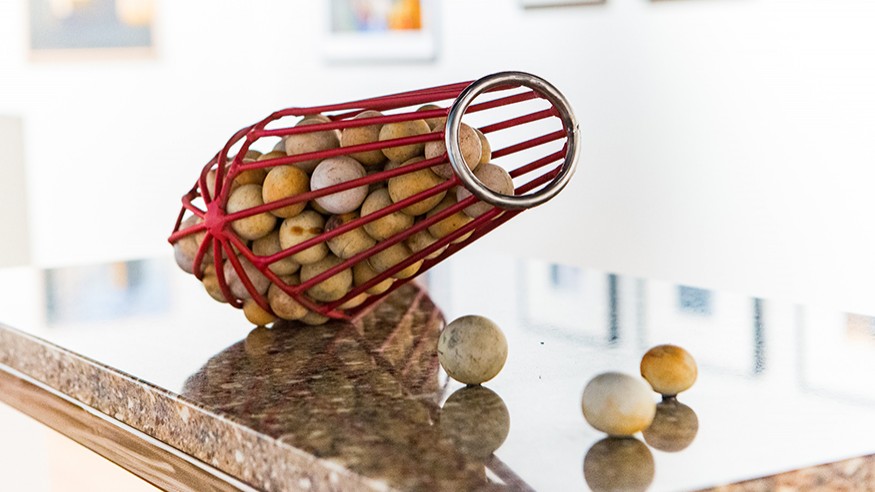
Ohio Wesleyan's Fine Arts Faculty Exhibit Latest Creations
Works from Seven Accomplished OWU Artists at Ross Art Museum through Jan. 31
DELAWARE, Ohio – The artistic muse is always “In Close Proximity” for Ohio Wesleyan University’s fine arts faculty, who are exhibiting their latest works from Dec. 1 through Jan. 31 at OWU’s Richard M. Ross Art Museum, 60 S. Sandusky St., Delaware.
Seven studio arts professors have created works for the “In Close Proximity” exhibition, showcasing their skills in media including clay, metal, photography, printmaking, sculpture, painting and drawing, and computer design.
Ohio Wesleyan faculty members participating in the free exhibit, which represents their biennial art showcase, are:
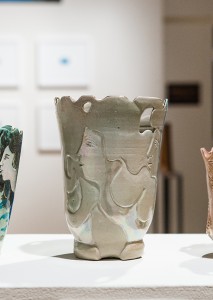
Untitled / Bogdanov
(Cone 6 electric fire, gold luster, and mother of pearl cone 018)
Kristina Bogdanov, M.F.A., who teaches ceramics, drawing, figure drawing and 3-D design. She is represented in the show with pottery, sculpture, and wall hangings. “I was very much drawn by the myth, legend and folklore of my native country,” said Bogdanov, who joined Ohio Wesleyan in 2007. “Lately, I am particularly interested in finding examples of powerful women in history and literature of Serbia. One of the most archaic ones illustrate a female spirit, a nymph, that has a mind of her own. … My hope is to inspire and honor the powerful women around me, of any age and culture to nurture their inner nymph spirit, to make choices of their own.”
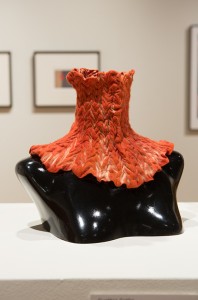
Madder Red Gangi by Cynthia Cetlin
(neckpiece, wool)
Cynthia Cetlin, M.F.A., who teaches metals, 3-D design, art education, and art history. Cetlin’s current work involves working with wool, including stitched resist textile techniques and natural dyeing. “With most of the work here, I did not know until after the piece was out of the dye pot, dried for days, the knots cut and the threads pulled away, whether I would have something worth looking at,” said Cetlin, a member of the OWU faculty since 1987. “It has been a risky process when preparing work for public view, but inescapable and thrilling. I am an ardent learner, always drawn to new techniques and to materials that are new to me. A constant in my life has been the desire to create body adornment and to develop knowledge and technical mastery.”
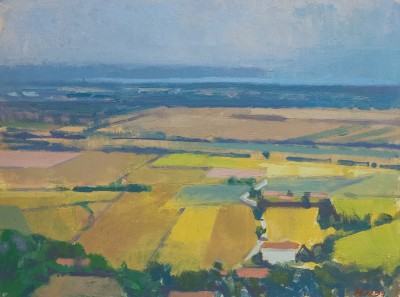
Italy-Lake Trasimeno from Panicale by Frank Hobbs
(oil on panel)
Frank Hobbs, M.F.A., who teaches painting, drawing, figure drawing, and 2-D design. Hobbs often paints Ohio landscapes, seeking to distill the scenes to their essence. “The foundation of my practice as a painter has always been a simple empiricism, a kind of natural philosophy based on observation and informed by the means of painting, which are color, gesture, shape, and texture,” said Hobbs, who joined the university in 2007. “The goal, ultimately, is to construct a living metaphor in color, shape, and mark for my experience of the concrete world. The thrill when the first crude likeness appears is still as fresh and exciting as it was when I first started painting, nearly four decades ago.”
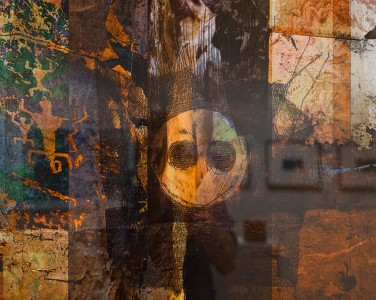
Jailhouse Moons triptych by James Krehbiel
(archival pigment print)
James Krehbiel, M.F.A., who teaches in the 2-D media of printmaking, computer imaging, and drawing. Krehbiel’s work represents his current research into kiva sites in the American Southwest. “Often kivas are isolated on remote ledges high in the canyons, but sometimes they are positioned in interesting ways in villages with alignments to unusual features in the landscape,” said Krehbiel, a member of the OWU faculty since 1986. “As I have become more interested in these contextual relationships, it has occurred to me that the intriguing alignments may have been set up to utilize astronomy. … All of the pieces in this exhibition are direct responses to my past three years of archaeoastronomical and archaeological experiences in the field. Each piece is created to become a narrative about what was discovered at a particular place.”
Justin Kronewetter, M.F.A., director of the Ross Art Museum, who teaches art gallery management. Kronewetter’s digital photographs often showcase common subjects in uncommon ways. “I take particular satisfaction in finding my subject matter among those things that are normally overlooked due to their presumed insignificance, things that are ‘hidden in plain sight,’” said Kronewetter, a retired OWU professor who joined the university in 1972. “Rather than wanting to show every conceivable aspect of a particular subject, I’m more interested in eliminating everything but that which I consider absolutely essential to the making of an effective image. In that respect I embrace the German-born American architect Mies van der Rohe’s dictum that ‘less is more.’”
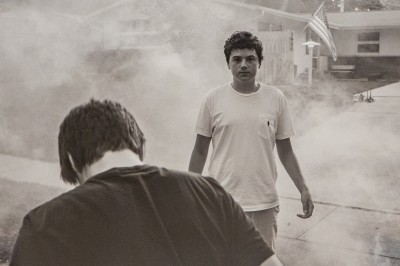
Walker and Avery, Lincoln, Nebraska by Jeff Nilan
(archival pigment print)
Jeff Nilan, M.F.A., who teaches photography, computer imaging, bookmaking, and 2-D design. Much of his current work was created while working as an artist-in-residence at the Ucross Foundation in Wyoming, an artist residency situated on a 20,000-acre cattle ranch. “Although the landscape is not an entirely new subject for me, having a month to slowly move through the wide-open high plains, both familiar and intriguing to me, challenged me to reconcile with the landscape as subject – developing my awareness of subtleties in the seemingly endless expanse of treeless hills,” said Nilan, who joined the OWU faculty in 2008. Additional work in the show was created during travel-learning trips with students and during the renovation of historic Merrick Hall.
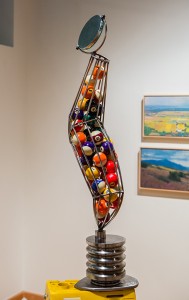
Revolver by Jonathan Quick
(stainless steel, fiberglass, plastic, electric motor)
Jonathan Quick, M.F.A., who teaches sculpture and 3-D design. He works primarily in steel and iron, creating large-scale sculptures. “Steel offers me the freedom and range of expression that no other three dimensional medium can match,” said Quick, who joined the university in 1988. “Working with steel gives me a more spontaneous approach to art making, allowing me to quickly render form and arrive at compositional solutions. Iron is one of the most plentiful earth elements. … I am drawn to the process of iron casting using a cupola furnace to smelt scrap iron. Pouring molten iron into wooden molds produces a violent interaction of materials. … [T]he process allows me to create new forms that remind me of their volcanic origin.”
Ohio Wesleyan offers a Bachelor of Fine Arts degree with majors in studio art, art education, and art history. Learn more about the OWU Department of Fine Arts and its faculty at www.owu.edu/finearts.
During the academic year, the Ross Art Museum is open Tuesday, Wednesday, and Friday from 10 a.m. to 5 p.m.; Thursday from 10 a.m. to 9 p.m.; and Sunday from 1 p.m. to 5 p.m. The museum will close Dec. 17 for winter break and reopen Jan. 12. The museum is handicap-accessible and admission is always free. Call (740) 368-3606 or visit www.owu.edu/ross for more information.
Founded in 1842, Ohio Wesleyan University is one of the nation’s premier liberal arts universities. Located in Delaware, Ohio, the private university offers 86 undergraduate majors and competes in 23 NCAA Division III varsity sports. Ohio Wesleyan combines a challenging, internationally focused curriculum with off-campus learning and leadership opportunities to connect classroom theory with real-world experience. OWU’s 1,750 students represent 46 U.S. states and territories and 43 countries. Ohio Wesleyan is featured in the book “Colleges That Change Lives,” listed on the latest President’s Higher Education Community Service Honor Roll with Distinction, and included in the U.S. News & World Report and Princeton Review “best colleges” lists. Learn more at www.owu.edu.
